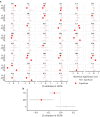Ozone as an environmental driver of influenza
- PMID: 38704386
- PMCID: PMC11069565
- DOI: 10.1038/s41467-024-48199-z
Ozone as an environmental driver of influenza
Abstract
Under long-standing threat of seasonal influenza outbreaks, it remains imperative to understand the drivers of influenza dynamics which can guide mitigation measures. While the role of absolute humidity and temperature is extensively studied, the possibility of ambient ozone (O3) as an environmental driver of influenza has received scant attention. Here, using state-level data in the USA during 2010-2015, we examined such research hypothesis. For rigorous causal inference by evidence triangulation, we applied 3 distinct methods for data analysis: Convergent Cross Mapping from state-space reconstruction theory, Peter-Clark-momentary-conditional-independence plus as graphical modeling algorithms, and regression-based Generalised Linear Model. The negative impact of ambient O3 on influenza activity at 1-week lag is consistently demonstrated by those 3 methods. With O3 commonly known as air pollutant, the novel findings here on the inhibition effect of O3 on influenza activity warrant further investigations to inform environmental management and public health protection.
© 2024. The Author(s).
Conflict of interest statement
The authors declare no competing interests.
Figures





References
Publication types
MeSH terms
Substances
Grants and funding
- 18192061/Food and Health Bureau of the Government of the Hong Kong Special Administrative Region | Health and Medical Research Fund (HMRF)
- 20211551/Food and Health Bureau of the Government of the Hong Kong Special Administrative Region | Health and Medical Research Fund (HMRF)
- 82173469/National Natural Science Foundation of China (National Science Foundation of China)
- 2022A1515011151/Natural Science Foundation of Guangdong Province (Guangdong Natural Science Foundation)
LinkOut - more resources
Full Text Sources
Medical

